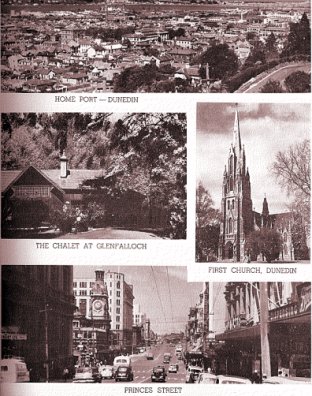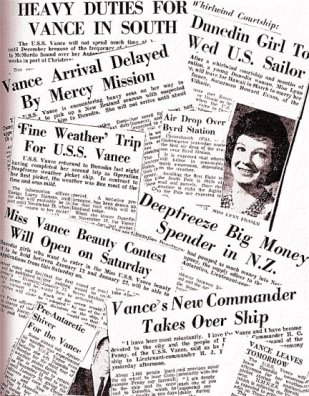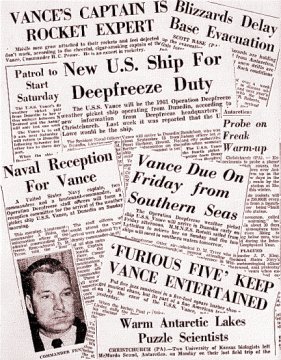Picture df51
 Home port - Dunedin, Chalet at Glenfalloch, 1st Church - Dunedin, Princess Street Home port - Dunedin, Chalet at Glenfalloch, 1st Church - Dunedin, Princess Street
 Bridge top Bridge top

Picture df52
 Papeete Harbour and Bali Hai Papeete Harbour and Bali Hai
 Otago -- Haven to U.S. Ships for 130 years. Otago -- Haven to U.S. Ships for 130 years.
 When the U.S.S.Vance sailed through Taiaroa Heads on September 10, 1961, she became part of a traditional American association with Otago harbour almost as old as European use of the port When the U.S.S.Vance sailed through Taiaroa Heads on September 10, 1961, she became part of a traditional American association with Otago harbour almost as old as European use of the port
 The Vance also became part of the younget tradition of using Dunedin as a point of departure and return for Antarctic expeditions. The Vance also became part of the younget tradition of using Dunedin as a point of departure and return for Antarctic expeditions.
 Early documents tell of American whalers visiting the Port of Otago in the 1820's and 1830's. In those days they had as much cause to call the port their own as the British whalers did, for no valid and permanent claim to the sovereignty of New Zealand had then been established by Great Britain. Early documents tell of American whalers visiting the Port of Otago in the 1820's and 1830's. In those days they had as much cause to call the port their own as the British whalers did, for no valid and permanent claim to the sovereignty of New Zealand had then been established by Great Britain.
 But the old "shellbcrcks" of the Massachusetts whalers saw a vastly different harbour from that seen by the crew of the Vance. But the old "shellbcrcks" of the Massachusetts whalers saw a vastly different harbour from that seen by the crew of the Vance.
 In those days it was difficult even to find the narrow harbour entrance -- one of the few havens on the east coast of New Zealand's South Island -- let alone enter it safely. In those days it was difficult even to find the narrow harbour entrance -- one of the few havens on the east coast of New Zealand's South Island -- let alone enter it safely.
 In 140 years the changes to the face of the harbour and the whole province have been vast. Then, the harbour hills were covered in thick bush. There were no leading or channel marks. In 140 years the changes to the face of the harbour and the whole province have been vast. Then, the harbour hills were covered in thick bush. There were no leading or channel marks.
 Today it would be almost impossible to miss the well-buoyed and lit channel, even in fog, for the Taiaroa Head signal station and lighthouse can "talk " a ship right into the harbour with the aid of radar. Today it would be almost impossible to miss the well-buoyed and lit channel, even in fog, for the Taiaroa Head signal station and lighthouse can "talk " a ship right into the harbour with the aid of radar.
 At the head of the harbour now lies the city of Dunedin--100,000 people in a prosperous community. At the head of the harbour now lies the city of Dunedin--100,000 people in a prosperous community.
 In 1848 the first settlers for the town of Dunedin arrived from Scotland in the ships John Wickliffe and Phillip Laing which dropped anchor at Port Chalmers. In 1848 the first settlers for the town of Dunedin arrived from Scotland in the ships John Wickliffe and Phillip Laing which dropped anchor at Port Chalmers.
 The new settlers were staunch members of the Free Church of Scotland and for a long time the settlement bore the imprint of a church colony in a tradition not dissimilar to that of America's own Pilgrim Fathers. The new settlers were staunch members of the Free Church of Scotland and for a long time the settlement bore the imprint of a church colony in a tradition not dissimilar to that of America's own Pilgrim Fathers.
 But the quiet pace of the new little pioneer town which grew up meeting the needs of farmers and owners of the vast sheep runs of the Otago hinterland was shattered by the discovery of gold in Otago in 1861. But the quiet pace of the new little pioneer town which grew up meeting the needs of farmers and owners of the vast sheep runs of the Otago hinterland was shattered by the discovery of gold in Otago in 1861.
 The miners and prospectors who had flocked to the great Australian gold rushes and the Californian discoveries of 1848 came to Otago in their thousands. The miners and prospectors who had flocked to the great Australian gold rushes and the Californian discoveries of 1848 came to Otago in their thousands.
 In no time Dunedin became a roaring, roisterous boom town. Gold was discovered in large quantities in many of the hills and rivers of the province and with it came the industrial and railroad development which made the emergence of a fully-fledged city and rural community possible. In no time Dunedin became a roaring, roisterous boom town. Gold was discovered in large quantities in many of the hills and rivers of the province and with it came the industrial and railroad development which made the emergence of a fully-fledged city and rural community possible.
 Gold brought the heavy industry which became the basis of Dunedin's early wealth. Gold brought the heavy industry which became the basis of Dunedin's early wealth.
 According to reporis of 1925, the character of Dunedin, peaceful and reticent, changed overnight when a flotilla of 12 United States destroyers, two minelayers and a store ship, the U.S.S. Melville, flagship at the time of Rear-admiral Marvell, visited Dunedin for 10 days. According to reporis of 1925, the character of Dunedin, peaceful and reticent, changed overnight when a flotilla of 12 United States destroyers, two minelayers and a store ship, the U.S.S. Melville, flagship at the time of Rear-admiral Marvell, visited Dunedin for 10 days.
 It was Dunedin's first major contact with the United States Navy and the sailors were given a great welcome. It was Dunedin's first major contact with the United States Navy and the sailors were given a great welcome.
 The tradition still lives as men of the Vance witnessed in 1961. The tradition still lives as men of the Vance witnessed in 1961.
 Men of the flotilla, 2,000 of them, " were not shy for long " and left full of praise for Dunedin hospitality. Men of the flotilla, 2,000 of them, " were not shy for long " and left full of praise for Dunedin hospitality.
 As a port and city, Dunedin plays a minor though most important role in Operation Deepfreeze. Deepfreeze aircraft have used the Dunedin airport from time to time. Four weather picket ships in six seasons have been based at Dunedin. As a port and city, Dunedin plays a minor though most important role in Operation Deepfreeze. Deepfreeze aircraft have used the Dunedin airport from time to time. Four weather picket ships in six seasons have been based at Dunedin.
 They were the U.S.S. Brough, Peterson, Wilhoite and Vance. The Brough and the Peterson both belonged to the Atlantic fleet and were DE's with no special radar conversion like the Wilhoite and Vance. They were the U.S.S. Brough, Peterson, Wilhoite and Vance. The Brough and the Peterson both belonged to the Atlantic fleet and were DE's with no special radar conversion like the Wilhoite and Vance.
 The first of the many famous Antarctic expeditions to call at Dunedin either on the outward or homeward voyage was that of the Englishman, Geoge Newnes, in the auxiliary barque, Southern Cross, in March, 1899. The first of the many famous Antarctic expeditions to call at Dunedin either on the outward or homeward voyage was that of the Englishman, Geoge Newnes, in the auxiliary barque, Southern Cross, in March, 1899.
 That most famous Antarctic explorer, Captain Robert Falcon Scott, brought his first Antarctic ship, the Discovery, to Duedin in December, 1901. Nine years later he left Port Chalmers for the ice on his last voyage in the Terra Nova on November 29, 1910. That most famous Antarctic explorer, Captain Robert Falcon Scott, brought his first Antarctic ship, the Discovery, to Duedin in December, 1901. Nine years later he left Port Chalmers for the ice on his last voyage in the Terra Nova on November 29, 1910.
 In 1916, another famous Britisher, Ernest Shackleton, docked his ship, Aurora, at Port Chalmers for repairs. In 1916, another famous Britisher, Ernest Shackleton, docked his ship, Aurora, at Port Chalmers for repairs.
 Admiral Richard Byrd had a long association with Dunedin, He first called with his ships, City of New York and Eleanor Belling, in 1929 on his way south and returned five months later. Admiral Richard Byrd had a long association with Dunedin, He first called with his ships, City of New York and Eleanor Belling, in 1929 on his way south and returned five months later.
 Lincoln Ellsworth, who gave his name to a large area of the Antarctic continent, visited Port Chalmers in the Wyatt Earp in February, 1934, and Admiral Byrd returned again the next month with the Tacob Ruppert and the famous Bear of Oakland. Lincoln Ellsworth, who gave his name to a large area of the Antarctic continent, visited Port Chalmers in the Wyatt Earp in February, 1934, and Admiral Byrd returned again the next month with the Tacob Ruppert and the famous Bear of Oakland.
 Admiral Byrd made his final visit with his 1946-47 expedition which included the well-known icebreakers and store ships, Merrick, North Wind and Yancy. Admiral Byrd made his final visit with his 1946-47 expedition which included the well-known icebreakers and store ships, Merrick, North Wind and Yancy.
 In 1951, the British came again with the Royal Research Ship, Discovery II. In 1951, the British came again with the Royal Research Ship, Discovery II.
 Last but not least, the Port Chalmers drydocks and shipyards have given assistance to American naval ships in peace and war. Last but not least, the Port Chalmers drydocks and shipyards have given assistance to American naval ships in peace and war.
 The drydocks are always available for repair work on Deepfreeze ships damaged by ice and have been used for this purpose on several occasions. The drydocks are always available for repair work on Deepfreeze ships damaged by ice and have been used for this purpose on several occasions.
 During World War II, Port Chalmers made a considerable contribution to the American and Allied war effort in the Pacific by building mine-sweepers, landing craft and even a cargo vessel for the United States forces. During World War II, Port Chalmers made a considerable contribution to the American and Allied war effort in the Pacific by building mine-sweepers, landing craft and even a cargo vessel for the United States forces.
 The visit of the Vance is part of a tradition in which Dunedin people take pride. United States Navy men are always welcome in a friendly and homely South Pacific city. The visit of the Vance is part of a tradition in which Dunedin people take pride. United States Navy men are always welcome in a friendly and homely South Pacific city.
 Bridge top Bridge top
Picture df53
 Headlines from local newspapers Headlines from local newspapers
 Bridge top Bridge top

Picture df54
 Headlines from local newspapers Headlines from local newspapers
 Bridge top Bridge top

Picture df55
 Headlines from local newspapers Headlines from local newspapers
 Bridge top Bridge top

| 


 Home port - Dunedin, Chalet at Glenfalloch, 1st Church - Dunedin, Princess Street
Home port - Dunedin, Chalet at Glenfalloch, 1st Church - Dunedin, Princess Street Bridge top
Bridge top

 Papeete Harbour and Bali Hai
Papeete Harbour and Bali Hai Otago -- Haven to U.S. Ships for 130 years.
Otago -- Haven to U.S. Ships for 130 years. Headlines from local newspapers
Headlines from local newspapers Bridge top
Bridge top

 Headlines from local newspapers
Headlines from local newspapers Bridge top
Bridge top

 Headlines from local newspapers
Headlines from local newspapers Bridge top
Bridge top
